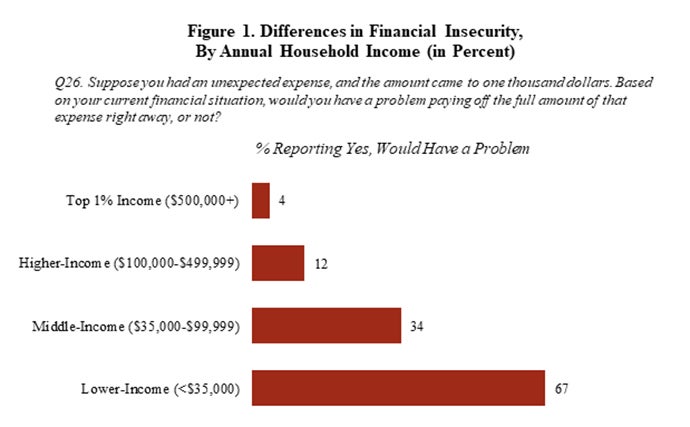Poll: Adults in the top 1% highest income bracket have dramatically different life experiences than middle- and lower-income adults when it comes to financial problems, health care, and life satisfaction

For immediate release: Thursday, January 9, 2020
Boston, MA – According to a new NPR/Robert Wood Johnson Foundation/Harvard T.H. Chan School of Public Health poll, while only 4% of the top 1% highest income adults say they would struggle to pay off an unexpected $1,000 expense, 34% of middle-income adults and 67% of lower-income adults say they would have problems paying this amount (see Figure 1 below).
In addition, while only 8% of adults with the top 1% highest incomes say their families have experienced serious problems paying for medical bills, dental bills, or prescription drugs in the past few years, nearly half of middle-income adults (48%) and a majority of lower-income adults (57%) say this (see Table 1 below).
View the complete poll findings.
January 27, 12:00 ET—Watch a live webcast from Harvard Chan School’s Forum: Life Experiences and Income Inequality in the U.S.: Implications for Health
Findings from this poll show stark income differences in both the ability to handle financial setbacks and quality of life (see Table 2 below). While most adults in the top 1% highest income category (90%) say they are completely or very satisfied with their lives, fewer middle-income adults (66%) and lower-income adults (44%) say this. And when it comes to satisfaction in their personal financial situation, only 38% of middle-income adults and 20% of lower-income adults say they are completely or very satisfied, compared to 87% of the top 1% highest income adults.
There are also differences in reported anxiety among groups, as only 9% of the top 1% highest income adults say they are very anxious about their future, compared to 19% of middle-income adults and 29% of lower-income adults.
This poll, Life Experiences and Income Inequality in the United States, was conducted among a national sample of 1,885 adults living in the United States. The sample was stratified in four groups by household income[1]: adults in the top 1% highest income households (earning at least $500,000/year), adults in higher-income households (earning $100,000-$499,999/year), adults in middle-income households (earning $35,000-$99,999/year), and adults in lower-income households (earning less than $35,000/year). Due to the heterogeneity of incomes in the higher-income household category, analyses in this report focus on differences between the top 1% highest income compared to middle- and lower-income adults, though results are included for all four income groups. See the Methodology for further details on income categories.
“These findings reinforce national concerns about the impact of large-scale income inequality in the U.S. today,” said Robert J. Blendon, co-director of the survey and the Richard L. Menschel Professor of Health Policy and Political Analysis at Harvard T.H. Chan School of Public Health.
Despite the problems facing many middle- and lower-income Americans, a majority of adults across income levels believe the American Dream is still within reach. When it comes to opportunity in America today, virtually all of the top 1% highest income adults say they have achieved the American Dream (73%) or they are on their way to achieving it (24%), with only 3% saying it is out of reach. Among middle-income adults, 37% say they have achieved the American Dream, 45% say they are on their way to achieving it, and 15% say it is out of reach for them. Among lower-income adults, 20% say they have achieved the American Dream, 36% say they are on their way to achieving it, and 40% say it is out of reach for them.
In addition, the vast majority of parents and grandparents across income groups believe their children or grandchildren will achieve the American Dream (80% of the top 1% highest income adults, 78% of middle-income adults, and 70% of lower-income adults).
Hard work stands out as the factor chosen by most Americans across all income groups as essential or very important to being economically successful in America today (see Table 3 below; 93% of the top 1% highest income adults, 89% of middle-income adults, and 87% of lower-income adults).
However, despite research showing several other factors such as family income, neighborhood, and race/ethnicity are closely tied to economic achievement, fewer than four in ten adults across all income groups believe these factors are essential or very important to being economically successful in America today (Table 3).
When it comes to reducing income differences between people with high incomes and those with low incomes, only about one in four adults in the top 1% (27%) believe it should be a very important priority for government to address this issue, compared to 42% of lower-income adults who share this view. Meanwhile, 34% of middle-income adults believe it should be a very important priority for the President and Congress to address income inequality.
Although a majority of adults across income groups do not believe it is a top priority for government to reduce income inequality, an overall majority (57%) do believe very wealthy Americans should pay more in taxes than they do now. This includes nearly half of the top 1% highest income adults (48%) and majorities of middle-income and lower-income adults (55% and 61%, respectively) who believe very wealthy Americans should pay more in taxes than they do now.
“It is simply unacceptable in a country as wealthy as ours that so many people lack sufficient income to pay for health care, housing or even food,” said RWJF President and CEO Rich Besser. “We need to address income inequality if we truly want everyone to have a fair and just opportunity to live the healthiest life possible.”
In addition, a majority of adults across all income groups say it is a very important priority for the President and Congress to make sure everyone living in the U.S. has health insurance coverage (53% of the top 1%, 59% of middle-income adults, and 71% of lower-income adults).
[1] Top 1% highest income defined as household incomes of $500,000+/year, using Census data. Higher-income defined as $100,000-$499,999/year, or more than four times the 2019 federal poverty level (FPL) for a four-person family, up to the top 2% highest household incomes. Middle-income defined as $35,000-$99,999/year, or above 138% FPL up to approximately four times the 2019 FPL for a four-person household. Lower-income defined as <$35,000/year, or less than 138% of the 2019 FPL for a four-person household. 138% FPL is the eligibility threshold for some federal aid programs for low-income households; see HHS Poverty Guidelines for 2019 for detailed information on FPL.

NPR/Robert Wood Johnson Foundation/Harvard T.H. Chan School of Public Health, Life Experiences and Income Inequality in the United States, 7/17/19 – 8/18/19. Q26. N=1,885 adults ages 18+.
Table 1. Serious Problems with Paying Bills in the Past Few Years, By Annual Household Income (in Percent)
Q25. Within the past few years, have you or any members of your household ever had a serious problem… or not?
| Lower-Income Adults | Middle-Income Adults | Higher-Income Adults | Top 1% Income Adults | |
| % Reporting Serious Problems | ||||
| Paying for medical bills, dental bills, or prescription drugs | 57 | 48 | 30 | 8 |
| With the cost of college/higher education | 33 | 30 | 23 | 12 |
| Paying your credit card debt/other debt | 33 | 31 | 21 | 6 |
| Finding an affordable place to live | 35 | 22 | 11 | 4 |
| With your rent/house payment | 24 | 17 | 7 | 1 |
| Paying for food | 30 | 12 | 3 | <1 |
NPR/Robert Wood Johnson Foundation/Harvard T.H. Chan School of Public Health, Life Experiences and Income Inequality in the United States, 7/17/19 – 8/18/19. Q25. N=1,885 adults ages 18+. Categories ranked by overall highest % among all respondents.
Table 2. Life Satisfaction, By Annual Household Income (in Percent)
Q22. Please tell me whether you are satisfied or dissatisfied with your… [If satisfied]: Would you say you are completely satisfied, very satisfied, or somewhat satisfied?
| Lower-Income Adults | Middle-Income Adults | Higher-Income Adults | Top 1% Income Adults | |
| % Reporting They are Completely/Very Satisfied | ||||
| Life (in general) | 44 | 66 | 82 | 90 |
| Job | 44 | 58 | 76 | 83 |
| Current housing situation | 47 | 63 | 77 | 91 |
| Education | 46 | 53 | 71 | 86 |
| Personal financial situation | 20 | 38 | 61 | 87 |
NPR/Robert Wood Johnson Foundation/Harvard T.H. Chan School of Public Health, Life Experiences and Income Inequality in the United States, 7/17/19 – 8/18/19. Q22-23. N=1,885 adults ages 18+. Job satisfaction only asked among employed adults. Categories ranked by overall highest % among all respondents.
Table 3. Views on the Importance of Factors in Achieving Economic Success, By Annual Household Income (in Percent)
Q14. For each of the following, please tell me how important you think it is for being economically successful in America today. How important is…
| Lower-Income Adults | Middle-Income Adults | Higher-Income Adults | Top 1% Income Adults | |
| % Reporting Essential/Very Important | ||||
| Hard work | 87 | 89 | 90 | 93 |
| Knowing the right people | 68 | 61 | 52 | 51 |
| Graduating from college | 61 | 50 | 57 | 60 |
| Having well-educated parents | 53 | 48 | 41 | 54 |
| Graduating from a professional school (e.g., medical, law, business) | 56 | 41 | 33 | 40 |
| Coming from an upper-income family | 37 | 37 | 29 | 33 |
| Growing up in an upper-income neighborhood | 37 | 30 | 29 | 34 |
| Graduating from a highly ranked college | 39 | 25 | 19 | 23 |
| A person’s racial/ethnic background | 33 | 24 | 26 | 27 |
NPR/Robert Wood Johnson Foundation/Harvard T.H. Chan School of Public Health, Life Experiences and Income Inequality in the United States, 7/17/19 – 8/18/19. Q14. N=1,885 adults ages 18+. Categories ranked by overall highest % among all respondents.
Methodology
The poll in this study is part of an on-going series of surveys developed by researchers at the Harvard Opinion Research Program (HORP) at Harvard T.H. Chan School of Public Health in partnership with the Robert Wood Johnson Foundation and National Public Radio. The research team consists of the following members at each institution.
Harvard T.H. Chan School of Public Health: Robert J. Blendon, Professor of Health Policy and Political Analysis and Executive Director of HORP; John M. Benson, Senior Research Scientist and Managing Director of HORP; Mary Findling, Senior Research Specialist.
Robert Wood Johnson Foundation: Carolyn Miller, Senior Program Officer, Research and Evaluation; Jordan Reese, Director of Media Relations; Martina Todaro, Research Associate.
NPR: Andrea Kissack, Senior Supervising Editor, Science Desk; Joe Neel, Deputy Senior Supervising Editor, Science Desk.
Interviews were conducted by SSRS of Glen Mills (PA) via telephone (including both landline and cell phone) using random-digit dialing, July 17 – August 18, 2019, among a nationally representative probability-based sample of 1,885 adults age 18 or older living in the United States. Interviews were conducted in English and Spanish. The margin of error for total respondents is ±3.2 percentage points at the 95% confidence level. The sample was stratified in four groups by household income: those in the top 1% highest income households in the U.S. (earning at least $500,000/year), those in higher-income households (earning $100,000-$499,999/year), those in middle-income households (earning $35,000-$99,999/year), and those in lower-income households (earning less than $35,000/year).
| Number of interviews (unweighted) | Margin of error at the 95% confidence level (percentage points) | Weighted % of total sample | |
| Total adults | 1,885 | +/-3.2 | 100 |
| Income groups (household income) | |||
| Less than $35,000 | 516 | +/-5.5 | 27 |
| $35,000 – $99,999 | 687 | +/-5.0 | 44 |
| $100,000 – $499,999 | 408 | +/-6.5 | 27 |
| $500,000 or more | 250 | +/-8.7 | 1 |
Due to the heterogeneity of incomes in the higher-income category, analyses in this report focus on differences between the top 1% highest income compared to middle- and lower-income adults, though results are included for all four income groups.
Possible sources of non-sampling error include non-response bias, as well as question wording and ordering effects. Non-response in telephone surveys produces some known biases in survey-derived estimates because participation tends to vary for different subgroups of the population. To compensate for these known biases and for variations in probability of selection within and across households, sample data are weighted by cell phone/landline use and demographics (sex, age, education, and Census region) to reflect the true population. Other techniques, including random-digit dialing, replicate subsamples, and systematic respondent selection within households, are used to ensure that the sample is representative.
For more information:
Todd Datz
Harvard T.H. Chan School of Public Health
tdatz@hsph.harvard.edu
617-432-8413
###
Harvard T.H. Chan School of Public Health brings together dedicated experts from many disciplines to educate new generations of global health leaders and produce powerful ideas that improve the lives and health of people everywhere. As a community of leading scientists, educators, and students, we work together to take innovative ideas from the laboratory to people’s lives—not only making scientific breakthroughs, but also working to change individual behaviors, public policies, and health care practices. Each year, more than 400 faculty members at Harvard Chan teach 1,000-plus full-time students from around the world and train thousands more through online and executive education courses. Founded in 1913 as the Harvard-MIT School of Health Officers, the School is recognized as America’s oldest professional training program in public health.
For more than 40 years the Robert Wood Johnson Foundation has worked to improve health and health care. We are working with others to build a national Culture of Health enabling everyone in America to live longer, healthier lives. For more information, visit www.rwjf.org. Follow the Foundation on Twitter at www.rwjf.org/twitter or on Facebook at www.rwjf.org/facebook.
NPR connects to audiences on the air, online, and in person. More than 26 million radio listeners tune in to NPR each week and more than 30 million unique visitors access NPR.org each month, making NPR one of the most trusted sources of news and insights on life and the arts. NPR shares compelling stories, audio and photos with millions of social media users on Facebook, Twitter, Instagram, Pinterest, YouTube and Snapchat; NPR News and NPR One apps, online streaming, podcasts, iTunes radio and connected car dashboards help meet audiences where they are. NPR’s live events bring to the stage two-way conversations between NPR hosts and the audience in collaboration with the public radio Member Station community. This robust access to public service journalism makes NPR an indispensable resource in the media landscape.


